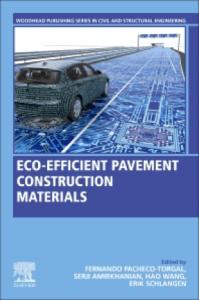A CAIT-affiliated researcher contributed to editing a new book, “Eco-efficient Pavement Construction Materials,” that provides engineers with the latest information and research on eco-efficient pavement materials and how pavements can become green infrastructure to improve the sustainability of transportation infrastructure and systems.

The text provides engineers with the latest information and research on eco-efficient pavement materials and green infrastructure. Photo ©Hao Wang.
A new book on eco-efficient pavement construction materials covers everything from recycled waste to pavements for climate change mitigation and pavements with energy harvesting potential for civil and environmental engineers involved in transportation projects.
“Eco-efficient Pavement Construction Materials” was co-edited by Dr. Hao Wang, an associate professor of civil and environmental engineering at Rutgers University and an affiliated researcher at the Center for Advanced Infrastructure and Transportation (CAIT).
The book looks at the state of the environment and the role that civil engineering plays in it, specifically the effects of pavement materials on the environment. It is divided into four distinctive parts that emphasize pavements with recycled waste and techniques for recycling, cool pavements for climate change mitigation, self-healing materials for long-lasting pavement, and smart pavements with energy harvesting potential and electric charging ability.
“This book is important for civil engineers, environmental engineers, and transportation engineers and managers who are considering various materials for pavement construction projects,” Dr. Wang said. “It offers key research findings and potential applications that could help make the pavement industry more green and eco-efficient.”
Dr. Wang and his doctoral students contributed two chapters of the book on life-cycle assessment of pavement recycling and piezoelectric energy harvesting from pavement. Recent research projects led by Dr. Wang address some related energy and environmental concerns as discussed in the book.
For example, he recently led a team of Rutgers researchers who developed designs for permeable concrete that is highly effective in handling heat and potentially mitigating “urban heat island effect” that causes cities to sizzle in the summer. His study found that permeable concrete pavement gives off slightly more heat on sunny days compared with conventional concrete pavement, but 25 to 30 percent less heat on days after rainfall.
His research has found that keeping road pavement in good shape saves money and energy and reduces greenhouse gas emissions, more than offsetting pollution generated during road construction. Another pilot project saw Rutgers researchers detail a potential system to generate sustainable electricity from roads and bridges by harvesting the kinetic energy of vehicles using piezoelectric materials in pavement.
“It is important to understand eco-efficient pavement materials and new technologies that consider environmental impacts,” Dr. Wang said. “And, ‘Eco-efficient Pavement Construction Materials’ provides engineers and decision-makers with these new research findings and potential applications for the next generation of long-lasting, sustainable, and smart pavement.”
For more here is breakdown of the new book:
Part 1: Pavements with recycled waste
- Utilization of Scrap Plastics in Asphalt Binders
- Use of Waste Engine Oil in Materials containing Asphaltic Components
- Microstructure and performance characteristics of cold recycled asphalt mixtures
- Life-Cycle Assessment of Asphalt Pavement Recycling
Part 2: Pavements for climate change mitigation
- Cool pavements
- Optical and thermal properties of reflective coatings for high albedo pavement
- Influence of ageing on the performance of cool coatings
Part 3: Self-Healing pavements
- Self-healing property and road performance of asphalt binder and asphalt mixture containing microcapsule
- Self-healing biomimetic microvascular containing oily rejuvenator for prolonging life of bitumen
- Self-healing pavements using microcapsules containing rejuvenator: From idea to real application
- Novel magnetically-induced healing in road pavements
Part 4: Pavements with energy harvesting potential and vehicle power charging ability
- Thermoelectric technologies for harvesting energy from pavements
- Piezoelectric Energy Harvesting from Pavement
- Electrified road systems for sustainable road transport

